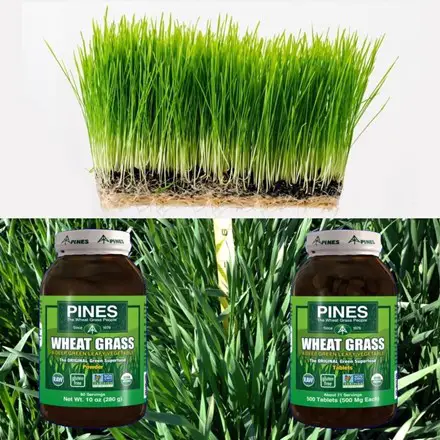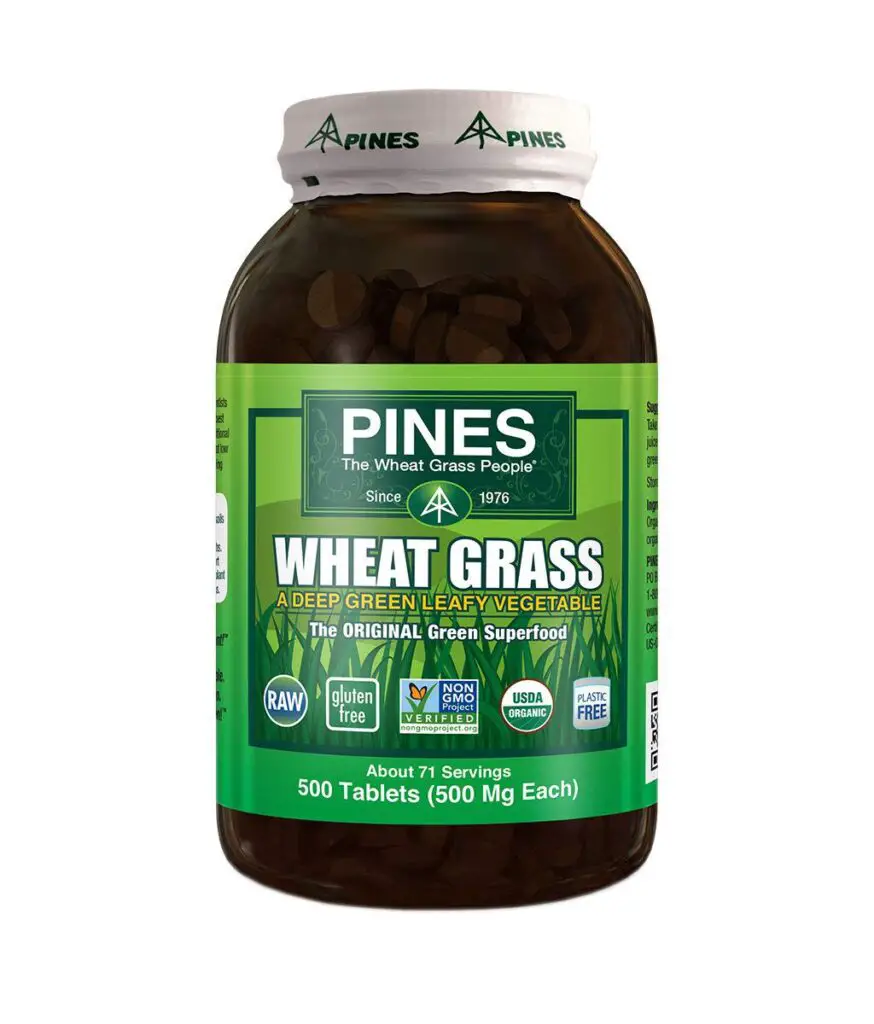It’s not too late to join the whole-food wheatgrass craze. Some may feel that whole-food wheatgrass is a health fad associated with obsessed fitness freaks. People become hooked on daily wheatgrass because they need more greens. According to the United States Department of Agriculture, dark green, leafy vegetables are deficient in 90% of diets. Whole-food wheatgrass powder and tablets are prebiotic foods with fiber and dark green leafy vegetable nutrition missing from diets. The USDA also says that a lack of whole-food dark green vegetables may help cause many modern diseases.
Other health advantages of wheatgrass range widely from boosted energy to overall beauty resulting from a healthy digestive system and proper elimination of toxins. Are you not yet persuaded? After reading this article, we hope you understand why including Pines whole-food wheatgrass tablets and powder in your daily regimen is an excellent idea to provide the vegetable nutrition and fiber lacking in 90% of Western diets.
Doctors and governments have documented the lack of whole-food vegetable nutrition and fiber in most diets. Recent research from the University of Michigan showed that a diet of mostly juice, juice powders, other low-fiber greens such as algae, and low-fiber junk foods does not support the growth of essential probiotics for colon health and disease prevention.
Cross-cultural studies documented by Dr. David Reuban in his best-selling book, “The Save Your Life Diet,” showed that indigenous diets are rich in whole-food vegetables and other foods that contain abundant fiber. As a result, these cultures have virtually none of the “diseases of civilization,” such as cancer, heart disease, and colon issues.
Dr. Reuban correctly concluded in 1970. The additional recent research at the University of Michigan proves that our colons require prebiotic plant-based whole foods, especially dark green, leafy vegetables with fiber intact, to grow healthy probiotics. Major universities used Pines Wheat Grass for probiotic research because they found it the perfect media for growing probiotics. All evidence indicates that a high-fiber diet is vital for colon health and preventing disease conditions caused by a lack of proper intestinal flora because of a lack of fiber in food.
Chlorophyll and other vital minerals found in wheatgrass have many health advantages besides the high-quality vegetable fiber. Immunity, food cravings, blood sugar, skin conditions, inflammation, burns, oral health, and fertility are potential benefits of whole-food veggies such as whole-food wheatgrass.

The standard wheat plant, Triticum aestivum, is a subspecies of the family Poaceae. In its life cycle to produce more grain, the wheat plant goes through a grass stage where it builds a high nutritional level in preparation for making seed. This grass stage is popularly called “wheatgrass.” a young gluten-free, nutrient-dense grass that later supports the development of the wheat grain.
True wheatgrass is grown outdoors at cold temperatures in rich soil and harvested at a particular once-a-year time in the early spring when it reaches its peak level of nutrient density. About 60 days after the wheatgrass, the plant has utilized the reservoir of nutrition in the wheatgrass to produce more grain.
Medical research using wheatgrass began in 1932. Published articles in medical journals regarding wheatgrass used led to the acceptance of it by the American Medical Association in 1939. That official notification describes wheatgrass and other cereal grasses as whole-food powder used as nutrient-dense human foods. Wheatgrass used in the published research was grown outdoors in cold weather, harvested at a particular time in the early spring, dried, and milled as whole food powder or tablets.
More recently, some people have grown wheatgrass indoors using trays. Besides the plants growing too quickly in too warm of conditions, the roots cannot go down a foot or more in the soil as is natural. Instead, wheatgrass grown in a tray produces a moldy mess of tangled roots in the bottom of the tray. The mold contaminates the grass and can create candida and other mold issues in the body. People usually squeeze this unnaturally grown wheatgrass into juice. As discussed, extensive research shows how juices create the wrong intestinal flora.
Nutrient-dense whole-food wheatgrass and other cereal grass, such as barley grass, is harvested only once at the “jointing stage.” That stage occurs after a slow growth outdoors in cold temperatures between 60 to 210 days after sowing the seed. The plant is about seven inches tall at that stage, shorter than unnatural wheatgrass when grown in a tray for ten days in warm temperatures. The jointing stage cannot develop in tray wheatgrass. The jointing stage discussed in the research is when the nearly microscopic seed head in the root, which has been developing over the months, begins its journey up the stem. If not harvested for wheatgrass powder at the jointing stage, the wheatgrass goes to supply the growing seed as it moves up a stem to emerge 30 to 60 days later and then ripens as a shaft of wheat gran.
Wheatgrass is at its most nutritious value for a few days only once a year. It must be grown naturally outdoors in often freezing temperatures to reach that stage. Naturally grown wheatgrass contains no gluten but more than four times more chlorophyll and nutrition than unnatural wheatgrass in trays. It has no molds that occur when wheatgrass is grown too quickly in warm trays. Natural wheatgrass can only be harvested one time, once each year, after a winter of slow growth in the early spring. True wheatgrass must be grown outdoors using deep soil in appropriate climates with often-freezing winter temperatures.
Wheatgrass has remarkable nutritional characteristics, including vitamins A, C, E, K, and B. Moreover, whole-food wheatgrass has essential elements like phosphorus, calcium, iron, magnesium, and potassium that our bodies require. True wheatgrass also contains necessary enzymes and amino acids. Chlorophyll, a phytochemical that gives dark leafy greens their color,
is the star of wheatgrass’ nutritional profile. In essence, chlorophyll is the lifeblood of plants. In people, chlorophyll-rich foods such as wheatgrass may slow aging, control appetite, purify the blood, eliminate odors, and even prevent diseases associated with not eating enough dark green leafy vegetables.
Again, wheatgrass grown naturally through the winter and harvested in the spring at the jointing stage contains at least four times more chlorophyll than the pale, spindly leaves of wheatgrass grown unnaturally in a tray. It also does not have mold, so candida and other mold conditions do not develop in the body.
Carina Parikh, MScN, MSiMR, a holistic nutritionist, says that wheatgrass, when grown correctly and consumed in whole food powder or tablet form, provides mineral components “in a balanced ratio that is beneficial for the human body.” The American Medical Association made a similar conclusion in their JAMA journal in 1939 after the extensive published research on whole-food wheatgrass powder. Ann Wigmore and other authors documented some of that research in books.
Benefits of Wheatgrass
Several studies suggest that consuming wheatgrass and its positive effect on the probiotics in the colon can help skin conditions. Whole-food wheatgrass is a rich source of nutrients and vegetable fiber that supports a healthy body and optimal colon function, both of which are necessary for weight loss.
Wheatgrass is a rich source of chlorophyll and other blood-building nutrients so that the blood can better provide oxygen. That is why top-performance athletes often use Pines Wheat Grass because they feel it gives them more stamina and endurance. Moreover, many athletes believe it helps in their recovery after exercise.

Pines Wheatgrass Tablets
Compared to spinach, Pines Wheat Grass is far richer in iron and chlorophyll pound for pound. It has an average protein content of 25%, almost all known vitamins, 20 amino acids, and the eight amino acids considered crucial for human health.
Pines Wheat Grass Tablets are a convenient and economical way to guarantee that you (and your children, if you have any) consume dark green veggies daily! They are 98% pure with only 2% natural organic ingredients to help make tablets. The powder is 100% pure and is excellent in whole-food smoothies and other recipes. Pines Wheat Grass is USDA Certified Organic, Non- GMO Project Verified, Kosher, raw, vegan, no sugar added, Gluten-free, prebiotic, and plant- based.
Pines Barley Grass Tablets
Another product from Pines is Pines Barley Grass (for those who prefer its taste over wheatgrass). It is also a cereal grass in the same family as wheatgrass. Also, it is a nutrient- dense, gluten-free whole food with the vitamins and minerals your body needs, antioxidants, beta-carotene, calcium, chlorophyll, fiber, and many other nutrients.
Pines cultivates both Pines Wheat Grass and Pines Barley Grass naturally. The company harvests both only once yearly and dries the leaves at the jointing stage when nutrition is at its highest level. Other green food companies package their products in plastic made from fossil fuel. Plastic packaging offers minimal protection of valuable nutrients.
Pines is the only green superfood company that uses amber glass bottles with special metal caps that allow the company to remove oxygen. Oxygen in the atmosphere is what causes nutrient loss (oxidation). Plastic containers cannot protect a product from oxidation. Even after dozens of years in sealed amber glass bottles, Pines products are still green and loaded with nutrition because the oxygen-free environment inside the bottle prevents loss of color and nutrition.
Pines follows the research praised by Ann Wigmore and other authors by growing our cereal grasses for up to 200 days in the correct climate in often freezing temperatures using fields of fertile glacial soil that are rich in nutrients and minerals. Unlike other companies that purchase
from factory farmers with an “organic sideline,” Pines is the only 100% certified organic company that grows greens sold in the natural food market. Pines is the only company that grows, harvests, packages, and ships from its farm. Pines is passionate about organic, non-GMO farming and has never used chemical poisons on our crops or fields. Pines still uses the same farm used by Dr. Schnabel, the father of wheatgrass, who first grew cereal grasses on our farm in 1932.
Unlike other growers who grow cereal grasses in inappropriate dry climates that require often- contaminated groundwater for irrigation, Pines uses only rainwater that falls naturally. Most of that time, the nighttime lows dip below freezing, and often the lows drop below freezing during the day. The leaves are only about an inch tall during the winter, but the roots go down more than a foot to keep the plant green even in the coldest temperatures. The plant grows slowly in cold weather resulting in a very dark green vegetable that grows to about 7 inches tall in the early spring or late fall at the jointing stage with a high concentration of nutrients.
As shown in this picture, the difference between wheatgrass grown naturally and in a tray is remarkable. The tray wheatgrass at the top is spindly sick-looking leaves compared to the healthy, vibrant, natural wheatgrass at the jointing stage in the early spring in the bottom picture. Notice how the true wheatgrass isn’t as tall as the tray wheatgrass, but the leaves of true wheatgrass are thick, fleshy, darker green, and healthier than the unnatural wheatgrass grown in a tray. Notice how the roots looking for a way to go deep in the soil in the tray wheatgrass became a tangled mess. When laboratories measure the mold level in the roots and leaves of the tray wheatgrass, it is exceptionally high, while natural wheatgrass grown outdoors in cold weather and bright sunlight has no mold at all.

Interesting Facts and History of Wheatgrass
Both Persian and Hindu rites and festivities have long utilized wheatgrass. As part of the ceremonies, Hindus sow wheat or barley seeds on the first day of Navaratri puja and present the seedlings to the mother goddess on the final day.
In the Western world, trials by the food scientist Dr. Charles Schnabel led the research of using wheatgrass and the grasses of other cereal grains as human food. That research began in 1932 with the whole-food wheatgrass powder that Schnabel supplied to doctors and hospitals. The wheatgrass was grown on the same farm now owned by Pines International.
Schnabel’s research is documented in books by Ann Wigmore, Viktoras Kulvinskas, Steve Meyerowitz, and other authors. Meyerowitz dedicated his wheatgrass book to Schnabel and called him “The Father of Wheatgrass.” Pines still operates one of Schnabel’s laboratories. The research by medical doctors and hospitals using whole-food wheatgrass powder from Pines’ farm led to the AMA’s acceptance of wheatgrass in 1939 as a nutrient-dense dark green, leafy vegetable. That proclamation still exists on the Journal of the American Medical Association website.
By 1940, major drug stores across the United States and Canada sold Schnabel’s powdered cereal grass in the same oxygen-free glass bottles that Pines still used. Ann Wigmore was a fervent promoter of Schnabel’s research and included wheatgrass in raw food diets. She praised and cited Schnabel’s research in her books. Schnabel grew, dried, and milled whole food wheatgrass powder that was raised outdoors slowly through the often-freezing winter temperatures in Northeastern Kansas and harvested at the yearly “jointing stage” that lasts only a few days in the early spring.
As a component of a raw food diet, Wigmore, the founder of the Hippocrates Health Institute, believed wheatgrass helps purge the body of toxins while offering a balanced array of nutrients. As the studies in medical journals she cited using Schnabel’s wheat grass indicated, Wigmore explained that wheatgrass is critical in treating serious illnesses.
Conclusion
Detoxification is not just for those with drug or alcohol abuse issues. After years on a low-fiber diet of juices, juice powders, and junk food, we must also detox our bodies from the damage from poor nutrition and lack of vegetable and other plant fiber, and unhealthy life habits. Going on a crash diet is a short-term fix if you live off low-fiber junk food, but it could do more long- term harm than good. Instead, detox your body by eating whole foods. Whole food dark green, leafy vegetables such as Pines Wheat Grass and Pines Barley Grass are particularly effective as economical and convenient tablets or powder mixed into smoothies and other foods.
A crucial step in detox is whole food cereal grass harvested at a particular time on Pines’ farm in the early spring or late fall. These superfoods contain hundreds of vitamins, minerals, enzymes, and amino acids that help your body get rid of toxins and cleanse your mind so you can be more effective and emotionally balanced.
The benefits of including Pines Wheat Grass or Pines Barley Gras in your daily diet are more than improved blood quality. These foods promote healthy digestion because chlorophyll-rich, nutrient-rich, and fiber-rich whole foods guard against constipation. Cereal grasses from Pines also encourage the production of digestive enzymes that help digestion. Pines’ cereal grasses provide essential, high-quality vegetable fiber and the dark green, leafy vegetable roughage missing in modern diets. High-fiber dark green roughage protects and creates a healthy colon and healthy body. A healthy colon helps prevent diseases associated with low-fiber diets of junk foods, juices, juice powders, and low-fiber greens like algae.
* In partnership with our friends at PINES International* Photo courtesy of PINES International
* These statements have not been evaluated by the Food and Drug Administration. These products are not intended to diagnose, treat, cure or prevent any disease.
* The information available on ewellnessmag.com, including text, graphics, and other materials is for informational purposes only. Reliance on any information in ewellnessmag.com is at the user’s own risk. Sponsored product placement may appear in the article. The visitor of this website acknowledges that the information available on or through ewellnessmag.com is not and is not intended to be a substitute for professional medical advice. Copyright © 2023 Brawo Press, Inc. All rights reserved.






